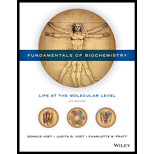
Concept explainers
(a)
To explain: The reason why hemoglobin variants do not generate same symptoms.
Concept introduction: Hemoglobin is the major oxygen carrying protein in the body. It carries oxygen from the lungs and delivers it to tissues for cellular
To explain: The way in which the symptoms of thalassemia differ.
Concept introduction: Hemoglobin is the major oxygen carrying protein in the body. It carries oxygen from the lungs and delivers it to tissues for cellular metabolism. It has four polypeptide chains that make up the four sub units of the hemoglobin. Hemoglobin variants have altered oxygen-binding capacity. Thalassemia is a result of a type of hemoglobian variant.
To explain: The hemoglobin variants that appear to offer a selective advantage under certain conditions.
Concept introduction: Hemoglobin is the major oxygen carrying protein in the body. It carries oxygen from the lungs and delivers it to tissues for cellular metabolism. It has four polypeptide chains that make up the four sub units of the hemoglobin. Hemoglobin variants have altered oxygen-binding capacity.
(b)
To describe: The structure and function of motor proteins.
Concept introduction: Motor proteins are the bridges between the two microtubules. Microtubules are involved in segregation of the sister chromatids during anaphase of the mitosis.
To explain: The fibrous proteins against which the motor proteins exert force.
Concept introduction: Motor proteins are the bridges between the two microtubules. Microtubules are involved in segregation of the sister chromatids during anaphase of the mitosis.
To explain: The way in which motor proteins differ from actin-myosin system.
Concept introduction: Motor proteins are the bridges between the two microtubules. Myosin proteins are those which bind on to actin microfilaments of the cell cytoskeleton.
(c)
To explain: The way in which immunological memory is exploited in the development of vaccines for viral and bacterial infections.
Concept introduction: Vaccines contain the antigen which can be a toxin or surface protein of a pathogen or any other molecule that is part of the pathogen in order to give active acquired immunity against pathogen infection or toxin released by the organism.
To explain: The factors that make a vaccine most effective for preventing disease.
Concept introduction: Vaccines contain the antigen which can be a toxin or surface protein of a pathogen or any other molecule that is part of the pathogen in order to give active acquired immunity against pathogen infection or toxin released by the organism.
Trending nowThis is a popular solution!

Chapter 7 Solutions
Fundamentals of Biochemistry: Life at the Molecular Level
- Problem 15 of 15 Submit Using the following reaction data points, construct Lineweaver-Burk plots for an enzyme with and without an inhibitor by dragging the points to their relevant coordinates on the graph and drawing a line of best fit. Using the information from this plot, determine the type of inhibitor present. 1 mM-1 1 s mM -1 [S]' V' with 10 μg per 20 54 10 36 20 5 27 2.5 23 1.25 20 Answer: |||arrow_forward12:33 CO Problem 4 of 15 4G 54% Done On the following Lineweaver-Burk -1 plot, identify the by dragging the Km point to the appropriate value. 1/V 40 35- 30- 25 20 15 10- T Км -15 10 -5 0 5 ||| 10 15 №20 25 25 30 1/[S] Г powered by desmosarrow_forward1:30 5G 47% Problem 10 of 15 Submit Using the following reaction data points, construct a Lineweaver-Burk plot for an enzyme with and without a competitive inhibitor by dragging the points to their relevant coordinates on the graph and drawing a line of best fit. 1 -1 1 mM [S]' s mM¹ with 10 mg pe 20 V' 54 10 36 > ст 5 27 2.5 23 1.25 20 Answer: |||arrow_forward
- Problem 14 of 15 Submit Using the following reaction data points, construct Lineweaver-Burk plots for an enzyme with and without an inhibitor by dragging the points to their relevant coordinates on the graph and drawing a line of best fit. Using the information from this plot, determine the type of inhibitor present. 1 mM-1 1 s mM -1 [S]' V' with 10 μg per 20 54 10 36 20 5 27 2.5 23 1.25 20 Answer: |||arrow_forward12:36 CO Problem 9 of 15 4G. 53% Submit Using the following reaction data points, construct a Lineweaver-Burk plot by dragging the points to their relevant coordinates on the graph and drawing a line of best fit. Based on the plot, determine the value of the catalytic efficiency (specificity constant) given that the enzyme concentration in this experiment is 5.0 μ.Μ. 1 [S] ¨‚ μM-1 1 V sμM-1 100.0 0.100 75.0 0.080 50.0 0.060 15.0 0.030 10.0 0.025 5.0 0.020 Answer: ||| O Гarrow_forwardProblem 11 of 15 Submit Using the following reaction data points, construct a Lineweaver-Burk plot for an enzyme with and without a noncompetitive inhibitor by dragging the points to their relevant coordinates on the graph and drawing a line of best fit. 1 -1 1 mM [S]' 20 V' s mM¹ with 10 μg per 54 10 36 > ст 5 27 2.5 23 1.25 20 Answer: |||arrow_forward
 BiochemistryBiochemistryISBN:9781319114671Author:Lubert Stryer, Jeremy M. Berg, John L. Tymoczko, Gregory J. Gatto Jr.Publisher:W. H. Freeman
BiochemistryBiochemistryISBN:9781319114671Author:Lubert Stryer, Jeremy M. Berg, John L. Tymoczko, Gregory J. Gatto Jr.Publisher:W. H. Freeman Lehninger Principles of BiochemistryBiochemistryISBN:9781464126116Author:David L. Nelson, Michael M. CoxPublisher:W. H. Freeman
Lehninger Principles of BiochemistryBiochemistryISBN:9781464126116Author:David L. Nelson, Michael M. CoxPublisher:W. H. Freeman Fundamentals of Biochemistry: Life at the Molecul...BiochemistryISBN:9781118918401Author:Donald Voet, Judith G. Voet, Charlotte W. PrattPublisher:WILEY
Fundamentals of Biochemistry: Life at the Molecul...BiochemistryISBN:9781118918401Author:Donald Voet, Judith G. Voet, Charlotte W. PrattPublisher:WILEY BiochemistryBiochemistryISBN:9781305961135Author:Mary K. Campbell, Shawn O. Farrell, Owen M. McDougalPublisher:Cengage Learning
BiochemistryBiochemistryISBN:9781305961135Author:Mary K. Campbell, Shawn O. Farrell, Owen M. McDougalPublisher:Cengage Learning BiochemistryBiochemistryISBN:9781305577206Author:Reginald H. Garrett, Charles M. GrishamPublisher:Cengage Learning
BiochemistryBiochemistryISBN:9781305577206Author:Reginald H. Garrett, Charles M. GrishamPublisher:Cengage Learning Fundamentals of General, Organic, and Biological ...BiochemistryISBN:9780134015187Author:John E. McMurry, David S. Ballantine, Carl A. Hoeger, Virginia E. PetersonPublisher:PEARSON
Fundamentals of General, Organic, and Biological ...BiochemistryISBN:9780134015187Author:John E. McMurry, David S. Ballantine, Carl A. Hoeger, Virginia E. PetersonPublisher:PEARSON





